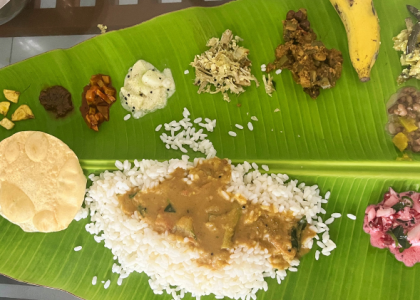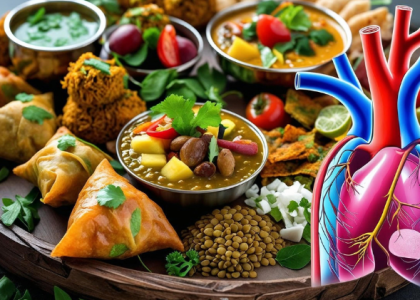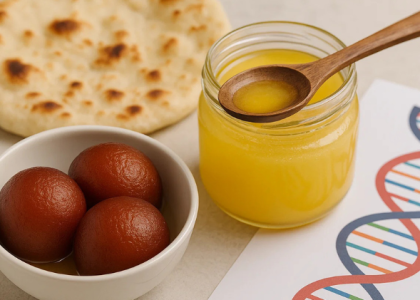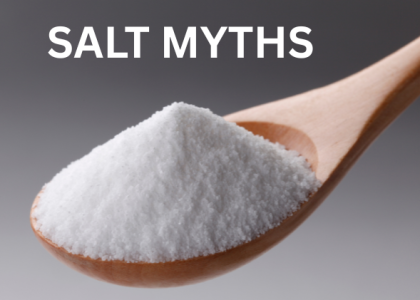Picture your last dinner: a plate piled high with fluffy chapati, steaming basmati rice, potato curry glistening with ghee, dal with a generous dollop of butter, and perhaps a small bowl of sweet curd or gulab jamun to finish. Your grandmother would be proud—this is exactly how she taught you to eat, how her grandmother fed the family, how love is expressed through abundance on the plate.
But what if I told you that this beautiful, traditional meal—served with the best intentions in millions of South Asian homes every night—might be quietly setting the stage for the heart attack that claims someone in our community every few minutes?
This isn’t about vilifying chapati or declaring war on rice. Our traditional foods sustained generations of ancestors through famines, wars, and hardships. The problem isn’t what we’re eating—it’s how we’ve changed the way we prepare it, serve it, and live around it. Somewhere between your great-grandmother’s kitchen and your dining table today, our relationship with food shifted in ways that our hearts are still trying to process.
The uncomfortable truth is that even home-cooked, vegetarian, “healthy” South Asian meals can silently drive up triglycerides, promote insulin resistance, and accumulate the dangerous belly fat that leads to early heart attacks. It’s not about good food versus bad food—it’s about understanding how traditional foods work in modern bodies living modern lives.
The Carb Trap: Why Chapati and Rice Aren't Always 'Healthy'
Let’s start with the foundation of most South Asian meals: wheat and rice. Your grandmother was right that these are wholesome, natural foods. What she couldn’t have predicted is how dramatically the way we consume them would change.
The Double Starch Problem: Walk into any South Asian home at dinner time, and you’ll likely see both chapati and rice on the same plate. This wasn’t traditional—most regions historically emphasized one grain or the other based on what grew locally. Today’s abundance means we often eat both, effectively doubling our carbohydrate intake at every meal.
Refined vs. Whole: Traditional chapati was made from whole wheat flour that included bran and germ. Modern refined flour removes these fiber-rich components, leaving behind pure starch that hits your bloodstream like sugar. Similarly, the polished white rice we prefer today has been stripped of its nutrient-dense outer layers.
When you eat chapati and rice together, your blood sugar spikes rapidly and stays elevated for hours. According to Harvard Health, this glycemic response is particularly problematic for South Asians, who are genetically predisposed to insulin resistance¹. Your body struggles to process these glucose surges, eventually becoming less responsive to insulin—the first step toward diabetes and heart disease.
Portion Distortion: Traditional serving sizes were much smaller than today’s standards. A single chapati was often shared between family members, and rice was served in small katoris, not heaping dinner plates. Today’s “normal” portions can contain 3-4 times the carbohydrates our ancestors consumed, but our activity levels have plummeted.
The result? Even people who “eat healthy” by avoiding processed foods can develop high triglycerides, insulin resistance, and the metabolic dysfunction that precedes heart disease. Your intentions are perfect, but your portions and combinations may be working against your heart.
The Ghee & Oil Problem: Quantity, Not Just Quality
Before you think this is an attack on ghee, let’s be clear: pure ghee in small amounts can be part of a healthy diet. The issue isn’t the ghee itself—it’s how liberally we use it and what we’ve added to our cooking repertoire.
The Volume Problem: Traditional cooking used minimal fat because it was precious and expensive. Today, many South Asian kitchens use oil and ghee generously, often without measuring. A typical potato curry might contain 4-6 tablespoons of oil, while traditional recipes would have used 1-2 teaspoons.
The Reheating Damage: Restaurant and even home cooking often involves reusing oil for multiple frying sessions. Each time oil is heated, it forms harmful compounds that promote inflammation and arterial damage. That crispy samosa or perfectly golden paratha may contain oils that have been heated and reheated multiple times.
Hidden Frying Everywhere: What used to be boiled, steamed, or lightly sautéed foods are now routinely fried. Vegetables are fried before being added to curries. Lentils are “tempered” with elaborate oil seasonings. Even roti is often brushed with ghee after cooking. The cumulative effect adds hundreds of extra calories and inflammatory fats to every meal.
Research published in the Indian Journal of Endocrinology & Metabolism shows that this pattern of high oil consumption, combined with refined carbohydrates, creates the perfect storm for metabolic syndrome in South Asian populations². The study found that even vegetarian South Asians had elevated markers of cardiovascular risk when their diets were high in refined grains and cooking oils.
The Processed Oil Problem: Many homes now use highly processed vegetable oils instead of traditional fats like mustard oil or small amounts of ghee. These industrially processed oils are high in omega-6 fatty acids, which promote inflammation when consumed in large quantities—especially when heated to high temperatures during cooking.
Missing Nutrients: Where's the Fiber, Omega-3, or Protein?
South Asian vegetarian cuisine has the potential to be incredibly heart-healthy, but modern interpretations often miss crucial nutrients while overemphasizing others.
The Fiber Gap: Traditional diets included plenty of fiber from whole grains, seasonal vegetables, and fruits. Today’s refined grains and limited vegetable variety mean many South Asian meals are surprisingly low in fiber. A typical dinner might include dal (good!), but served with white rice and minimal vegetables—missing the fiber needed to slow carbohydrate absorption and feed beneficial gut bacteria.
Protein Imbalance: While dal provides protein, the amounts typically consumed (1-2 small servings) often aren’t enough to balance the large quantities of carbohydrates on the same plate. This imbalance promotes blood sugar spikes and leaves people hungry shortly after eating, leading to snacking on carb-heavy foods.
Vegetable Variety Decline: Many families rely heavily on potatoes, onions, and tomatoes while avoiding bitter vegetables like karela, leafy greens, and fiber-rich options that our ancestors ate regularly. These traditional vegetables contain compounds that naturally help regulate blood sugar and reduce inflammation.
The Dairy Overload: Paneer, whole milk yogurt, and cream-based curries have become staples in many households. While dairy can be part of a healthy diet, the quantities and frequencies now common can contribute significantly to saturated fat intake—especially when combined with high-carb meals that promote fat storage.
Missing Omega-3s: Traditional South Asian diets included omega-3 rich foods like certain fish, flax seeds, and walnuts. Modern vegetarian diets often lack these anti-inflammatory fats entirely, creating an imbalance that promotes cardiovascular disease.
According to the World Health Organization, diets high in refined carbohydrates and low in fiber, regardless of whether they include meat, increase the risk of heart disease and diabetes³. For South Asians, who already have genetic vulnerabilities, these nutrient imbalances can be particularly harmful.
From Kitchen to Clinic: What the Labs Say

Here’s where the story gets personal and potentially shocking. Many South Asians eating traditional home-cooked meals discover at routine checkups that their blood work tells a different story than their healthy-looking lifestyle suggests.
The Normal Weight, Abnormal Labs Paradox: It’s increasingly common to see South Asians with BMIs in the “normal” range (22-25) but with metabolic profiles that look like those of much heavier people from other ethnic backgrounds. Their traditional meals—high in refined carbs and cooking oils—have created internal health problems that aren’t visible externally.
Common Lab Surprises:
- Triglycerides over 200 mg/dL (normal is under 150) despite “healthy” vegetarian eating
- HDL cholesterol under 40 due to high-carb, low-fiber diets that suppress good cholesterol
- HbA1c levels of 5.8-6.2% indicating prediabetes, even with normal fasting glucose
- High ApoB particles showing dangerous cholesterol patterns missed by basic lipid panels
Silent Warning Signs: Before the lab abnormalities appear, many people experience subtle symptoms they dismiss as normal aging or stress:
- Fatigue 2-3 hours after meals (blood sugar crashes)
- Difficulty losing weight despite eating “healthy” foods
- Increased belly fat, even with stable overall weight
- Family history repeating itself: parents’ diabetes or heart disease
The INTERHEART study, published in The Lancet, found that dietary patterns high in refined grains and fried foods were among the strongest predictors of heart attack risk in South Asian populations⁴. Importantly, this risk persisted even when people avoided Western fast foods and ate primarily traditional home-cooked meals.
Tests Every South Asian Should Request:
- HbA1c (shows 3-month blood sugar average)
- Triglycerides (often elevated from high-carb diets)
- ApoB levels (better than LDL for South Asian risk assessment)
- Waist-to-hip ratio (more predictive than BMI for our body types)
- High-sensitivity CRP (measures inflammation from diet and lifestyle)
Simple Swaps That Still Taste Like Home
The solution isn’t to abandon your cultural foods or start eating like someone from a completely different background. It’s about making strategic adjustments that honor tradition while protecting your heart.
Grain Upgrades:
- Mix, don’t eliminate: Use 50% whole wheat flour for chapati, 50% brown rice mixed with white rice
- Try traditional grains: Incorporate millets, quinoa, or barley 2-3 times per week
- Portion consciousness: Serve grains in smaller bowls, fill the extra space with vegetables
- One grain rule: Choose either chapati OR rice, not both at the same meal
Oil and Fat Strategies:
- Measure, don’t pour: Use measuring spoons for oil instead of estimating
- Choose quality fats: Use mustard oil, olive oil, or small amounts of ghee instead of processed vegetable oils
- Cooking method makeover: Steam, boil, or lightly sauté vegetables before adding to curries
- Air-frying revolution: Use air fryers or oven-roasting for foods traditionally deep-fried
Protein and Fiber Boosters:
- Double the dal: Increase lentil portions while decreasing grain portions
- Vegetable priority: Fill half your plate with non-starchy vegetables before adding grains
- Nuts and seeds: Add almonds, walnuts, or pumpkin seeds to meals for healthy fats and protein
- Bitter is better: Include traditional vegetables like karela, methi, and leafy greens weekly
Meal Timing and Habits:
- Post-meal walks: Even 10 minutes of walking after eating can reduce blood sugar spikes by 30%
- Lighter dinners: Make lunch your larger meal, keep dinners simple and early
- Mindful portions: Use smaller plates and serve food in the kitchen rather than family-style
- Sweet strategy: Save desserts for special occasions, not daily treats
Simple Daily Changes:
- Start meals with a small salad or raw vegetables
- Drink water or unsweetened tea instead of sweet lassi or juice
- Use spices liberally—turmeric, fenugreek, and cinnamon help regulate blood sugar
- Keep healthy snacks like roasted nuts available to avoid eating extra chapati when hungry
You Can Still Eat What You Love—Smarter
Chapati isn’t the enemy. Rice didn’t cause the South Asian heart crisis. The problem is that we’ve gradually moved away from the wisdom embedded in traditional eating patterns while keeping the foods but changing everything else about how we consume them.
Your great-grandparents ate smaller portions, moved constantly, fasted regularly between meals, and consumed a much wider variety of plants. They used minimal oil, ate seasonally, and treated sweets as rare celebrations rather than daily rewards. Most importantly, they balanced their plates differently—with more vegetables, moderate grains, and adequate protein.
The path forward isn’t about perfection or completely overhauling your kitchen. It’s about small, consistent changes that add up to significant health improvements over time. You can honor your cultural heritage while adapting it for modern health realities.
Start with one change this week:
- Add a side salad to dinner
- Use half the usual oil in one dish
- Take a 10-minute walk after your largest meal
- Replace white rice with brown rice twice a week
- Measure portions instead of estimating
Your heart doesn’t need you to become a different person or eat unfamiliar foods. It needs you to become a more conscious version of yourself—someone who enjoys traditional foods while understanding how they affect your body in your current life.
The choice isn’t between cultural authenticity and health. It’s between unconscious eating and informed eating. Between following outdated patterns and adapting them for optimal wellness.
Your ancestors would want you to thrive, not just survive. They’d want you to take their beautiful food traditions and make them work for your modern life, your modern challenges, and your modern opportunities for health and longevity.
The first step is understanding. The second step is action. What will you choose to change first?
Ready to make your plate work for your heart?
- Take our “Is Your Plate Protecting or Hurting Your Heart?” Quiz to get personalized recommendations for your eating patterns
- Download our “Heart-Smart Swaps for the South Asian Kitchen” checklist with simple substitutions that don’t compromise on taste
Share this article with family members who think home cooking automatically equals healthy eating—knowledge could save a life
References:
Harvard Health Publishing – The glycemic index and diabetes: https://www.health.harvard.edu/diseases-and-conditions/glycemic-index-and-glycemic-load-for-100-foods
Indian Journal of Endocrinology and Metabolism – Dietary patterns and metabolic risk factors among South Asians: https://www.ijem.in/article.asp?issn=2230-8210
World Health Organization – Healthy diet fact sheet: https://www.who.int/news-room/fact-sheets/detail/healthy-diet
INTERHEART Study – Effect of potentially modifiable risk factors associated with myocardial infarction: https://www.thelancet.com/journals/lancet/article/PIIS0140-6736(04)17018-9/fulltext
Centers for Disease Control and Prevention – South Asian Americans and heart disease: https://www.cdc.gov/heartdisease/asian_americans.htm




